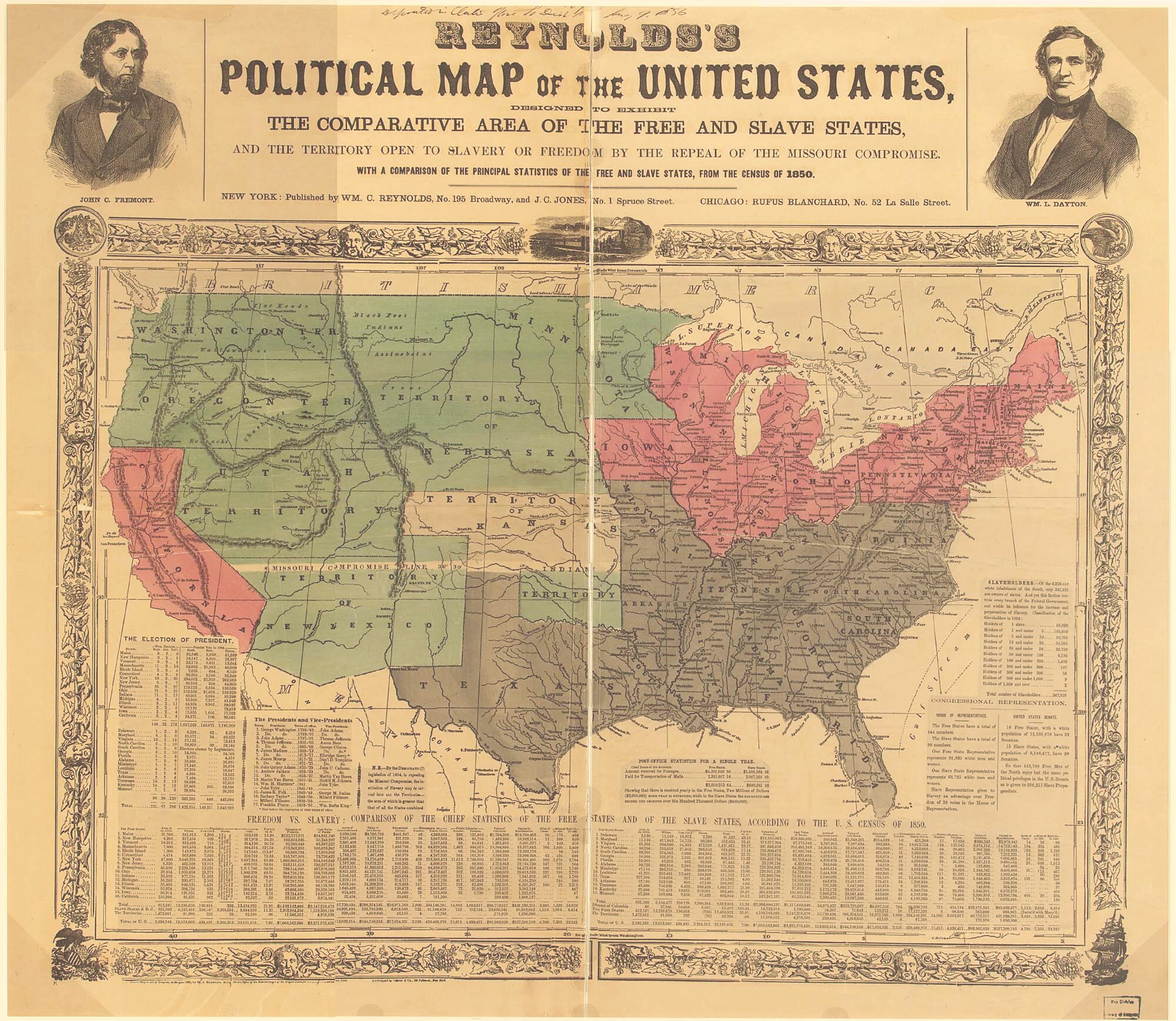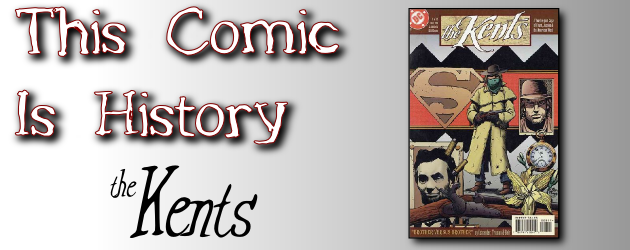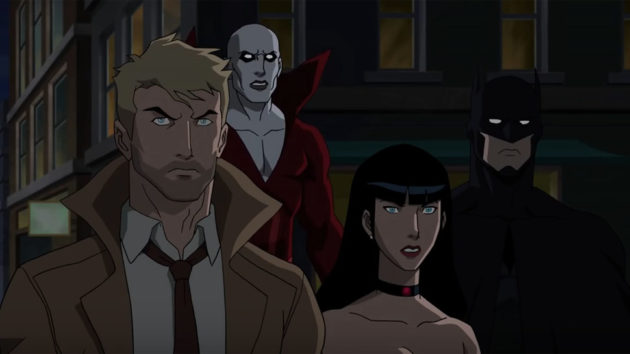For this installment of This Comic Is History, we’re traveling back in time to 19th century Kansas. The Kents, written by John Ostrander, is a twelve issue mini-series published in 1997, focusing on, as you might have guessed, the ancestors of Superman’s adoptive father, Jonathan Kent. This series contains many events from before, during, and after the Civil War. It gives insight into some of the events that lead to the war. It also helps us to see the people of that day, and how strongly they felt about their respective sides of the slavery issue. What’s more, it shows just how far some were willing to go to ensure that their way of life did not change.
The American Civil War was fought from 1861 through 1865, but it was the result of heated disputes that had been building for years prior. Some of these events took place in Kansas, and concerned the status of Kansas as it was becoming a state. The drama began in 1854, with the Kansas-Nebraska Act, which officially opened up Kansas to settlers, and did away with the Missouri Compromise of 1820. Basically, this meant that Kansas and Nebraska were now up for grabs between the abolitionists and their pro-slavery opponents. This is when abolitionist free-staters from New England, and pro-slavery settlers, mainly from Missouri, began flooding into the state. Missouri was a slave state, so there was no shortage of angry people to slip over the border into Kansas and voice their opinions, or worse. The rush was over whether or not Kansas would become officially designated as a free or slave state. Back then, states were one or the other, so naturally proponents on either side were eager to steer the area’s destiny with their vote. This resulted in some extreme violence, among other vile offenses. Its at this time that Silas Kent, ancestor to Superman’s father, left Boston to settle in Kansas. As it turned out, Kansas entered the Union in January of 1861, as a free state.
The Kents touches on many historical events and people, and handles them with great accuracy. Truly, if you are interested in Civil War history, this is the book for you. Silas Kent and his family may be fictional, but there are several historical figures included in this book, portrayed for the most part as history remembers them. People like John Brown, Custer, William Quantrill, and several others. Ostrander presents an impressive tale, one which reflects the research that he did before writing the story.
The Kents opens in April of 1854, with Silas helping Harriet Tubman and some escaped slaves out of a sticky situation with some slave catchers. He is a staunch abolitionist, the type of man who takes no crap when it comes to what he believes in. By the end of the first issue, he and his two sons, Nathaniel and Jebediah, have arrived in Kansas, choosing to settle in Lawrence. He made the move to help insure that Kansas became a free state. Silas believes wholeheartedly that slavery is a base evil. Not only that, but, just as the Declaration of Independence states, that every man is created equal, and should be treated as such. He publishes a newspaper, and the pro-slavery people don’t much like what he has to say in it. He turns out to be a genuinely noble, honest, and courageous man, a fitting ancestor for Clark Kent.
Trouble begins
“Ya’ll come a long way t’die yankee!” That was how Silas and his two sons were greeted when they arrived in Kansas City, Missouri, to begin their journey to Kansas. Encounters like this one became commonplace for the Kents, and they weren’t always limited to the use of words. Silas wasn’t a violent man, however he had no qualms about doing what he had to do to protect his family. It became clear to everyone that he was working toward the goal of making Kansas a free state. His outspokenness and courage in this regard gained him many enemies. Sadly, not long after settling in Lawrence, Silas was murdered, shot in the back by a pro-slavery Missourian.
Nate and Jeb Kent
Jebediah had always asked hard questions of his father. “Should we kill for someone else’s freedom? For a black man’s freedom?” Silas hadn’t always known exactly how to help his son see the rightfulness of their cause. Nate, the older of the two brothers, had no such troubles. He was firmly determined to continue what his father began, wholly devoted to the cause. Jeb however, never did get too attached to it, or to his brother for that matter.
Jeb never really agreed with his father and brother. He didn’t see how they were more in the right than the pro-slavery side. After their father’s death, Jeb drifted farther from his brother, and from the cause. He began keeping some questionable company, and got swept along in the anti-abolitionist fervor that so many of the border ruffians, as the pro-slavery activists of the area were then known, from Missouri were stirring up. Lawrence was becoming the center of the violence in the Kansas territory.
Things really get going
There had been elections in Kansas, which the pro-slavery people had won, though not without intimidation and violence at the polls, not to mention Missourians voting in a Kansas election. This prompted the free-staters to start up their own legislature, which angered the Missourians to no end. Things started to get serious when pro-slavery sheriff Sam Jones was shot while attempting to arrest a free-stater in Lawrence. Well, he survived, and returned with nearly 1,000 southerners. In May of 1856, they burned the town, destroyed its two printing presses, and threw some of their vital parts into the river, hoping to silence the abolitionist press. This event, known as the Sacking of Lawrence, was just one in a series of violent confrontations that made up the border war between anti-slavery free-staters and the pro-slavery border ruffians that came to be called Bleeding Kansas. This all lasted for a few years, cooling down a bit right before the start of the Civil War. The Kents presents these bloody skirmishes in good detail, as well as the political events surrounding the violence.
At one point the physical fighting merged with the political activity, in May of 1856. Senator Charles Sumner had made a speech denouncing slavery, that enraged southern legislators. A couple of days later Sumner was beaten into unconsciousness with a wooden cane, by fellow Senator Preston Brooks, whilst South Carolina Rep. Laurence Keitt kept others from aiding Sumner by holding his pistol on the onlookers. This all happened inside the Senate chamber! I can’t imagine seeing something like that on C-SPAN. Sumner was out of the Senate for three years, while recovering from his attack.
Quantrill
William Quantrill was active along the Missouri-Kansas border in the years prior to, and during the early part of, the Civil War, carrying out guerrilla raids on free-staters. Jeb Kent ended up riding with him, and taking part in all sorts of murder and mayhem. One day they showed up at a freed slave’s home in Lawrence. Jeb had suggested a spot where they might find some blacks to take back down south and sell for some money. Jeb knew of this family, Tobias and Sarah, and their son Joshua, because Nate had befriended them. Jeb thought it would be a kick to capture his brother’s friends. Well, when they arrived, Nate was there, and made sure that nobody got taken anywhere. Well, that is until Jeb put two bullets in his back. That’s right, Jeb killed his own brother, or so he thought. They took the parents, burned their home, and rode south. Nate wasn’t killed of course, but we’ll get back to him later.
Jeb continued on with Quantrill, traveling farther down into the depths of humanity as he went. Quantrill was leading a bunch of men, and though not officially soldiers, they were conducting guerrilla attacks on Union forces between Texas and Kansas. At some point Jesse James is introduced into Quantrill’s gang and befriends Jeb. Whether or not this is historically accurate is not verified, though Jesse’s brother Frank is said to have ridden with Quantrill’s men. Nonetheless, this acquaintance would later lead Jeb on to committing bank robbery, and more murder. We see his regret for his life’s course in his letters to his sister back in Boston, though he keeps making the wrong choices. Nate and Jeb lead separate lives for most of the war, though they have small encounters now and then.
As for Nate, well, after he healed from his gunshot wounds, he set off after Jeb. He also went in search of his friends, Tobias and Sarah, promising their son Joshua he’d find them, and bring them home. He found Sarah, though she died before he could reunite mother and son. He wouldn’t see his friend Tobias again for many years. He continued to look for his brother, determined to kill him. Eventually he gave it up, and settled down with a woman from Lawrence. He and his brother did reunite, even if for only one day. I’ll let you read for yourself how that turns out.
The history
Most of what’s in this story is real, and is attested to in the history books. Ostrander went to great lengths to include many details, so as to paint a vivid picture of this part of the country at the time. Aside from the Kent family, most of this is historically accurate. The violence in Lawrence, the attack on Senator Sumner, Quantrill’s raiders, Custer’s dealings with native Americans, the political events, John Brown’s craziness, and plenty more.

If you’re a Civil War buff, I suggest adding the Kents to your collection. I’ve found it to be one of the most historically accurate comics that I’ve read. Ostrander succeeds at giving us an entertaining history of the Kent family, including some nice interaction between Clark and Jonathan Kent. I especially recommend this book if you’re interested not just in Civil War history, but in the events surrounding the Kansas area that led up to the war.
I really enjoyed The Kents, for its merits both as a comic, and as a history of the Civil War. At times it made me furious with a sense of outrage at the disgusting injustice and human cruelty that it relates. For a slight moment I wondered why this comic, more so than any other had aroused such feelings. I mean, I can read about Thanos destroying half the universe and I’m not phased one bit. Then right away I remembered that this isn’t just a comic. This happened. It actually happened much the way that Ostrander depicted it. This kind of storytelling makes history very real. Being able to see the face of these men as they committed these acts, it really helps to bring home the gravity of it all. How despicably evil we humans have treated one another.
Looking at a character like Nathaniel Kent, I’d like to think that there were men of such honor back then. Those who fought with everything they had for what was right and never gave in, no matter the danger they faced. Of course, there were plenty of people like Nate, many who lost their lives in the struggle for not only what they believed, but for what actually was right.
Resources
There are so many historical characters that Ostrander mentions in this book that I can’t possibly get to them all. As far as reading material to support the history featured in The Kents, there’s no shortage whatsoever, but the following links should be a good start.
Kansas-Nebraska Act | Bleeding Kansas | Border Ruffian | John Brown | William Quantrill
Eli Anthony
eli@comicattack.net








That’s actually really cool. I’m not real keen on the art, but it’s an interesting event to put into the comic medium.
I have to agree with Eli, the way Ostrander incoporates real events into the Kent family history makes for a great read. I remember reading this when it originally came out and looking into some of the real characters, portrayed in the series. Thank you, Eli for bringing this often overlooked series to the attention of readers again.
Cool Article Eli. I agree with Dale, that incorporating real life events as much as possible makes this an even better book.
Thanks guys, this really was a success for the creative team. I mean, its like Ostrander took what could have been a history lesson, and made it entertaining.
@ Kristin — Yeah, the art didn’t do much for me either, but I think it being a little different from what we normally see, fit it well.
I’ve heard of this story and it was suggested to me a very long time ago however I wasn’t too interested in anything Superman related and didn’t know that it was more of a historical take. I’ll have to add this one to my collection..thanks Eli!